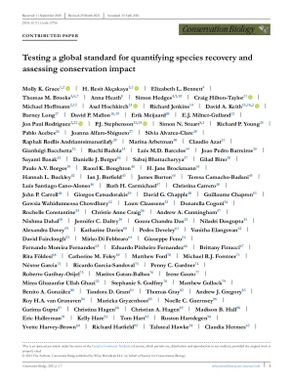Testing a global standard for quantifying species recovery and assessing conservation impact
- Description:
- This emphasizes that species recovery is conceptually different from extinction risk and reinforces the utility of the IUCN Green Status of Species to more fully understand species conservation status. Although extinction risk did not predict conservation legacy, conservation dependence, or conservation gain, it was positively correlated with recovery potential. Only 1.7% of tested species were categorized as zero across all 4 of these conservation impact metrics, indicating that conservation has, or will, play a role in improving or maintaining species status for the vast majority of these species. Based on our results, we devised an updated assessment framework that introduces the option of using a dynamic baseline to assess future impacts of conservation over the short term to avoid misleading results which were generated in a small number of cases, and redefines short term as 10 years to better align with conservation planning. These changes are reflected in the IUCN Green Status of Species Standard.
- Display date:
- 2021
- Location:
- Worldwide
- Collections:
- Secretariat of the Pacific Regional Environment Programme (SPREP)
- Publisher:
- Wiley
- Content partner:
- Secretariat of the Pacific Regional Environment Programme (SPREP)
- Availability:
- Not specified
-
Copyright status: All rights reservedFind out more about what you are able to do with this itemThis item is all rights reserved, with means you'll have to get permission from Secretariat of the Pacific Regional Environment Programme (SPREP) before using it. For more information, please see our use and reuse page.What can I do with this item?Non-infringing useNZ copyright law does not prevent every use of a copyright work, and this item may be hosted by an international institute or organisation. You should consider what you can and cannot do with a copyright work.No sharingYou may not copy and/or share this item with others without further permission. This includes posting it on your blog, using it in a presentation, or any other public use.No modifyingYou are not allowed to adapt or remix this item into any other works.No commercial useYou may not use this item commercially.
Related items
Welcome and warm Pasifik greetings
The information on this site has been gathered from our content partners.
The names, terms, and labels that we present on the site may contain images or voices of deceased persons and may also reflect the bias, norms, and perspective of the period of time in which they were created. We accept that these may not be appropriate today.
If you have any concerns or questions about an item, please contact us.
